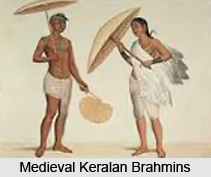 Social Life in Medieval Kerala witnessed continuity despite constant political changes. The Marumakkatayam system of inheritance and the economic independence of women were two unique features of the social life of Malabar. Women had the right to own their own property and were not dependent upon man. They enjoyed almost equal rights with men in many walks of life.
Social Life in Medieval Kerala witnessed continuity despite constant political changes. The Marumakkatayam system of inheritance and the economic independence of women were two unique features of the social life of Malabar. Women had the right to own their own property and were not dependent upon man. They enjoyed almost equal rights with men in many walks of life.
As ancient Kerala was part of Tamilakam its culture and language were the same as those of the Cholas and Pandyas. The political division of the country brought about a distinct change in customs and manners. Now the region had its own language, culture, organization, traditions and institutions
The two noteworthy features of the middle Ages were theocracy and feudalism. Namboodiris tried to establish a theocratic form of Government. Feudal institutions were prevalent in the country due to the peculiar civil and military organisation of the Nairs. The Namboodiris and Nairs effectively checked royal authority. These two communities occupied a prominent position in the history of Medieval Kerala.
Brahmins occupied a dominant position in Kerala due to their peculiar socio-political organisation. It is believed that the Namboodiris introduced caste as a political institution in Kerala. They also laid down in Sanskrit language the rules of life that regulated the most trivial actions. The Nairs were prohibited to learn Sanskrit. The Brahmins became a powerful sacerdotal class by the beginning of the middle Ages. They exercised their power in all the sixty four villages that extended from South Kannada to Central Travancore.
The Brahmans associated themselves with the government in various methods: they were the ministers of the Rajas, their officers on the Bench, their generals in the field and as spiritual preceptors. This was not peculiar to Malabar, but in no other part of India did the Brahmans possess so much say in political affairs. They constituted a national body and owed only nominal allegiance to the temporal power.
Their alliance with the royal families and the leading aristocrats with the Nairs was a factor that contributed to the enormous influence wielded by the Brahmans on the civil order of the day. Only the eldest son of a Namboodiri is allowed to marry in his own community. There were many rich Namboodiri Jenmis. They had a considerable voice in the sanketams due to their endowments to the temples.
The ruling and the fighting classes were preoccupied with warfare almost all the twelve months of the year. This helped the Namboodiris to strengthen their sectarian organisations and establish solidarity in the community. Their class-consciousness made them an extra-national community that resulted in reduction of royal authority.
The custom of the land: maryada, acharam or nattunadappu exercised a restrictive influence on the powers of the king. In fact the powers and privileges possessed by the high class was a product of the custom of the land. The king also had to abide by the customs.
However one cannot suppose that the mediaeval kings of Malabar were mere political nonentities. Their subjects were also bound by customs. A singular lack of central authority was a common feature of the mediaeval period; the rulers played the most important part in the government. Most of them were dependent upon the willing allegiance of their feudal nobility. The chiefs were asked to pay certain customary tributes to him and recognise his over lordship. The rulers also respected the rights of the chiefs and feudatories under them.
The relation between one ruler and another was governed by certain established customs, as the relation between the ruler and his subjects. Perpetual strife among the different states made it difficult to maintain peace in the middle Ages. There were certain rules of war which were bayed by the belligerents. One such rule was that the defeated ruler should be restored as a feudatory that was followed by the Malabar rulers till it was set aside by Marthanda Varma. Another rule was that the Nair lords should not be punished as ordinary individuals even when they go against constituted authority.
Desavali was mainly the military chief of his village who marched at the head of the quota of his soldiers during war time; he had other duties as well. He assisted the administration in the collection of fines forfeitures and other dues to the Government. He also decided petty suits and was responsible for establishing law and order. In order to ensure civil administration nadus were divided into gramams and Taras.






